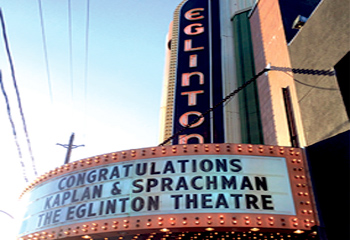When the Eglinton Theatre opened in 1936, it was hailed as a great example of art deco, the modernistic style that had become popular in Europe and North America in the 1920s and ’30s.
A year later, Kaplan & Sprachman, the Toronto architectural firm that designed the Eglinton, Famous Players’ flagship movie house at 400 Eglinton Ave. W. won the Royal Architecture Institute of Canada Bronze Medal for the theatre’s advanced style.
The midtown landmark – today it’s known as the Eglinton Grand – is characterized by its futuristic façade, a sleek vertical tower, round marquee with hundreds of lights, and ticket booth with its polymer and stainless steel frontage. Two hand-carved statues and a mural are striking features of the elegant interior.
On Nov. 15, Parks Canada and the Historic Sites and Monuments Board of Canada recognized the Eglinton as a national historic site, and the work done by Kaplan & Sprachman Architects as a national historic event.
About 60 people gathered at the Eglinton for a special ceremony to unveil plaques honouring the building and the architects. On hand were Richard Wishart of the Historic Sites and Monuments Board of Canada; members of the Kaplan and Sprachman families; descendants of Agostino Arrigo Sr., the man who built the theatre; Ellen Scheinberg of Heritage Professionals; and Sam D’Uva, managing director of Dynamic Hospitality and Entertainment Group, the company that restored the theatre and now runs it as an event venue.
Kaplan and Sprachman also designed the Canadian Odeon Vogue Theatre in Vancouver, which opened in 1941 and still operates as a movie house.
Abraham Sprachman, born in 1894, emigrated from Galicia as a youngster. He was directed to an architectural program in high school.
Harold Kaplan, born in Romania in 1895, arrived in Toronto in 1903. He learned drafting in Philadelphia, but he returned to Toronto, where he studied architecture at night school. In 1929, he and Sprachman formed a partnership that lasted 36 years.
They designed private homes and apartment houses for Jewish clients and community buildings such as Anshei Minsk Synagogue in Kensington Market, Congregation Beth Israel in Vancouver, and the Bloor Street Y (now the Miles Nadal JCC), respectively built in 1930, 1932 and 1953.
READ: TORONTO EXHIBIT FOCUSES ON CITY’S FIRST ACCREDITED JEWISH ARCHITECT
Another one of their designs – it was referred to as “the new” Mount Sinai Hospital (550 University Ave.) – was completed in 1953. Today it houses the Toronto Rehabilitation Institute and is next door to the present-day Mount Sinai.
However, Kaplan and Sprachman are best known for their innovative movie-house designs and are credited with some 300 movie theatre projects across Canada.
At the Parks Canada ceremony, Kaplan’s daughter, Phyllis Pepper, described her father as a hard-working man who went back to the office after dinner.
She recounted how he would set up a bridge table, hang a “do not disturb” sign and continue his architectural work on the beach during summers at the cottage.
“He was a loving father and grandfather and a real gentleman,” she said. “This is a great honour.”
Michael Wolfish, Sprachman’s oldest grandson, recalled going to the horse races with his grandfather. “He would let me listen to the radio station with rock music, because they would announce the racing results.”
Robert Sprachman remembered his grandfather as a round, jovial man who loved to gamble and play cards with his cronies from Beth Tzedec Congregation.
Seymour Baum and his father shared office space with the architects. Baum spoke of Sprachman’s readiness to offer him schnapps. “He kept a bottle in the bottom drawer of his desk.”
When Scheinberg, heritage expert and author, headed the Ontario Jewish Archives, she learned about the architectural firm through the late Martin Wolfish, Sprachman’s son-in-law.
She reconnected the Kaplan and Sprachman families to each other and helped them liaise with Parks Canada about 10 years ago. “It was so wonderful to see this all come to fruition and have these plaques that commemorate Kaplan & Sprachman and one of their finest theatres.”
